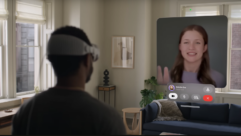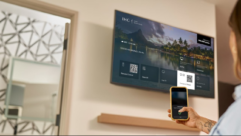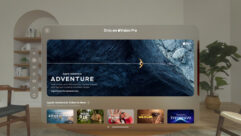
Is Yours an Apple iPad Home or an Amazon Kindle Home? Neither?
Nov 21, 2011 2:28 PM,
By Jason Bovberg

Apple iPad
I remember the first time I toyed around with a tablet PC, about 8 years ago. I was at a Microsoft conference, checking out one of the first Rugged Tablets from Motion Computing. It was a full PC experience—with an Intel 933MHz Pentium III processor, 256MB of RAM, and 60GB of hard disk space—and of course it came complete with an input stylus. I remember thinking, even then, that the tablet experience had a long way to go before it would gain acceptance beyond niche applications such as chart viewing in hospitals or contractor note-taking in the field. In short, this potentially exciting new form factor needed to get rid of the pen.
Which is what the Apple iPad did. And that made all the difference.
You can’t deny the convenience, of course. The usability and portability make the iPad a device like none we’ve ever seen. But is that aforementioned cool factor enough to keep this mobile-entertainment juggernaut surging forward? There have already been quite a few pretenders taking shots at the iPad—the HP Slate, the Dell Streak, the Motorola Xoom, the Samsung Galaxy Tab, and the RIM PlayBook among them—but most have failed outright, primarily because they lack, yes, that cool factor.

Amazon Kindle Fire
But surprisingly, the initial community reception was lackluster—from reactions to the device’s name (it still reminds one of, say, a techie feminine product) to the perception that the thing really didn’t do much more than Apple’s smaller iPod touch, just on a larger scale. More important, it also lacked a bunch of functionality that a user might expect in a tablet computer. But gradually that latter perception turned into the iPad’s most revolutionary aspect: It wasn’t a computer at all! It was a toy! Aimed primarily toward the consumption and enjoyment of media and entertainment (music, video, web content, books, games), the iPad almost completely eschewed the notion of tablet computing in favor of tablet horsing around.
And in play-obsessed 21st century America, the iPad became an essential component of the connected home. Anecdotal evidence here at the Connected Home labs suggests that consumers are buying $700 iPads more for Angry Birds than for anything productive such as bookkeeping or research or even ebook reading.
As silly as that sounds, there’s truth to the notion that many people are purchasing these incredibly expensive lap devices because of their undeniable cool factor—but actually using them for surprisingly mundane, trivial tasks that are either wastes of time or redundancies from what a laptop or desktop computer does equally well or better. I’ve heard tales of grandparents proudly carrying their fancy new iPads into their kids’ homes and letting their young grandkids fumble around with the device, swiping their sticky fingers through silly downloaded princess apps. And when the grandparents get the iPad back in their hands, all they want to do with it is check their email or play Solitaire.
Is Yours an Apple iPad Home or an Amazon Kindle Home? Neither?
Nov 21, 2011 2:28 PM,
By Jason Bovberg
But a new breed of lower-tech consumer tablets is rising, beginning with the Barnes & Noble Nook and culminating this week with the release of the Amazon Kindle Fire—both from companies with strong brand recognition and both from companies with a background focused on that decidedly antique method of media consumption: the book.
Perhaps we’re coming full circle here, then. In a sane world of consumer electronics, it would be something a little more modest like the Kindle Fire that would meet the trivial media-consumption needs of most users. At $199, the Kindle Fire is not so much an iPad competitor as a fun device on which to read and play—exactly what the iPad promises but for far less cash and (sure) minus quite the same cool factor. You might say it lacks the Apple gloss.
So, if you’re like most people, you’re now among the ranks of consumers who suddenly need a tablet device in their home. Are you an iPad person or a Kindle Fire person? Perhaps a look at some of the specs will help. One of the iPad’s advantages is its gorgeous 10in. screen, allowing you to take full advantage of HD video playback and image viewing. And you can really see those Angry Birds in all their colorful, cranky glory! The Kindle Fire offers a smaller 7in. screen—not as visually impressive, but it allows for a device that’s easier to hold in one hand and easier to carry. What about app selection? It’s an important question, as the vast majority of users point to the apps as the thing they enjoy most about tablet usage. In this case, Amazon wins, with its superior app selection (not to mention book selection and video streaming through Amazon Prime).
But wait, perhaps—like most people—you don’t care about specs. Look at how glossy that iPad is!
In the end, perhaps the Kindle Fire will shine a light on one of bigger headscratchers that the consumer electronics industry has endured in a long time—say, since Blu-ray beat HD-DVD to claim the HD video crown. For a couple years now, amazing numbers of consumers have been plunking down huge dollars for a device that lets them…play. We all have become starry-eyed in the face of this glossy, silly thing.
Or perhaps we’re just in an odd moment of transition, when the ideal application of the tablet device will eventually come clear. As a new home for magazines and newspapers, the tablet holds outstanding potential—but boring PDF-like replicas of physical incarnations aren’t the future. As a replacement for books, it’s gaining traction, but it will encounter resistance against our age-old print method for a long time to come—perhaps a generation or two. As a device for watching video, the tablet (with its tiny screen and woeful speakers) flies in the face of every notion of quality AV presentation we value in the home.
Until these applications sort themselves out, we’ll continue to buy these cool devices rabidly—only to get them home and realize they’re mostly style and little substance. Which makes it all the more sensible to start with something a little more reasonable, like the Kindle Fire.
Or just grab a book.










